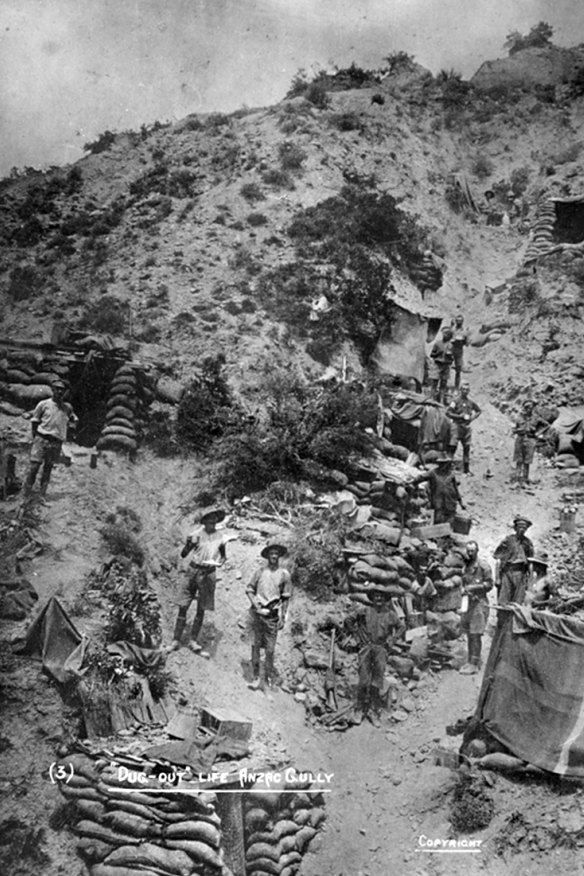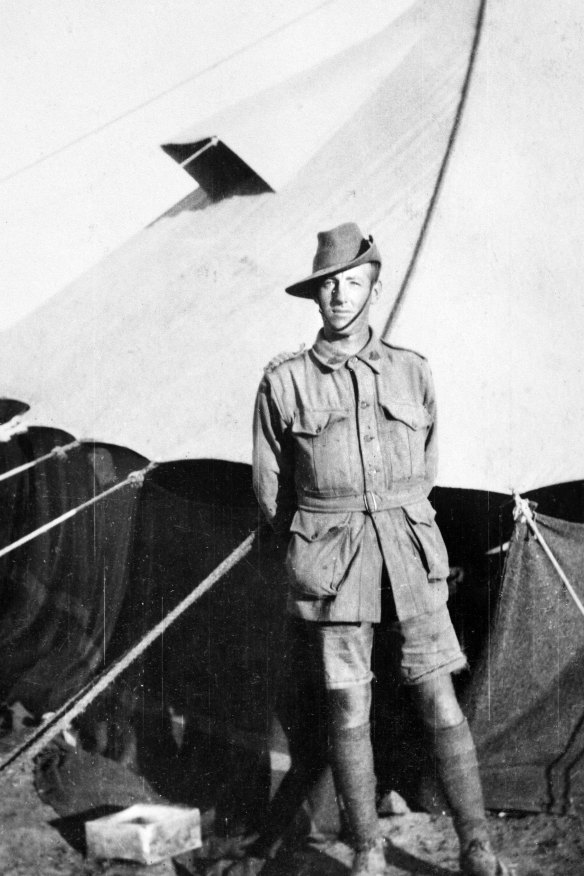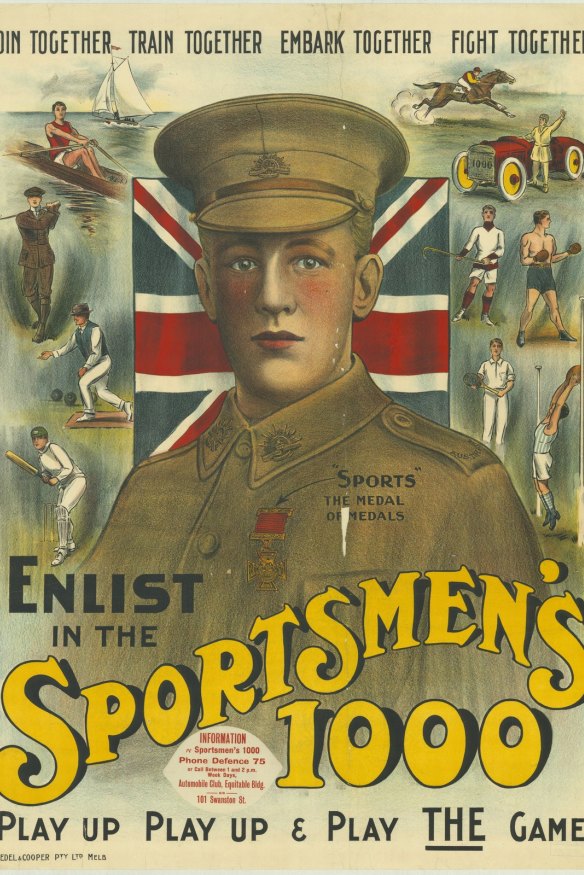This was published 8 months ago
‘Well, I managed to get the buggers, sir’: The daring plan that created a legend
At 4am on May 20, 1915, Turkish troops launched an attack on the Australians dug in at Courtney’s Post, Gallipoli. One man defending the maze of trenches, including the “traverses” that cut across the frontlines, was Albert Jacka.
And there is Albert Jacka ahead, crouching behind the traverse in the firing line. Well, that is one good thing. On the field, Jacka is the man most likely to lead a charge, and off the field a man quite likely to get one. For, yes, Jacka can be a bit rough around the edges – and only a couple of months before Sergeant Jim Cowey had charged him twice in a single day for insolence – but it is already obvious that he is a hell of a soldier, and never better than when under heavy fire.
For Jacka’s part, he feels both great relief at the sight of Lieutenant Crabbe coming his way down the communication trench – and alarm, shouting: ‘Look out, sir! Turks are in there!’
“What’s the situation?” Crabbe yells back.
“I am the only one left in the trench. The others have been [knocked out] by the bombs the enemy threw before rushing this section of the trench. I’ve been holding the Turks back from advancing further into our trenches for a quarter of an hour.”
“If you are given support,” Crabbe shouts to Jacka over the continuing cacophony of fire, exploding grenades and shrieking men, “will you charge the Turks?”
“YES! I want two or three.”
Jacka must hold on till they get here, and with a deathly calm that surprises even him – a man never knows how he will go until an actual crisis hits – he continues to keep the Turks in the next bay pinned down, firing at the first sign of any rifle appearing around the corner. For good measure, he thuds irregularly timed bullets into the trench wall beyond the corner so that the Turks know that the first man who attempts to make a rush on him risks collecting one of those bullets. No, he can’t kill them all, but he will certainly kill the first one or two if they rush him.
The other end of the Turkish breakthrough is equally blocked by an Australian communications trench that leads into the traverse on the right, and another group of the 14th Battalion is regularly firing down it, as a warning that any Turk who tries to jump across will cop it.

Australian troops dug in at Anzac Cove.Credit: State Library of NSW
Hurrying back to one of the support trenches, Crabbe asks for volunteers from A Company to come and help Jacka.
“Will you back Jacka up?” he calls over the ferocious fire of the machine guns and constant explosions, before adding unnecessarily, “It’s a tough job.”
Three hands immediately go up, all of them mates from around Bendigo: Lance Corporal Stephen De Arango, Lance Corporal Bill Howard and Private Frank Poliness. Since their first days leaving Bendigo, the three have taken a vow to stick tight to each other come what may – from brothers in farms, to brothers in arms – and have stuck to it through Broadmeadows, Cairo and Gallipoli. So, naturally, they are side by side, now, and volunteer together.
“It’s sink or swim,” Lance Corporal De Arango says on behalf of them all. “We will come, sir.”
Excellent. (And it is typical of De Arango. At six foot one he is likely the tallest man in the battalion, with only the former Carlton star, Lieutenant Alf “Lofty” Williamson, able to argue the toss with him, and he and his mates are always happy to volunteer for anything.)
They now hurry back down the communication trench, where, hopefully, Jacka is still holding the fort. Crabbe is all but certain he will be. Of all the men in his command, Crabbe could not have hoped to be relying on a better soldier than Jacka.
As they come towards him down the communication trench, Jacka is delighted to see they are three men he knows well, from his own neck of the woods, not far from Wedderburn.

The third line of Australian trenches at Gallipoli.Credit: State Library of NSW
“Hello, Bendigo!” he sings out. “Will you follow me?” “Yes!” Bill Howard calls back.
And ... now!
Alas, though Poliness manages to leap across the gap to join Jacka in his traverse, on the very instant that Lance Corporal Howard follows him, a shot rings out, and the Bendigo man is first struck in the left side with “an explosive bullet, fired at close range”, and another bullet shatters his right hand. As he goes down hard, Jacka and Poliness are at least able to grab the groaning, bleeding man, and drag him to safety, back into the communications trench, where it is time to regroup around Lieutenant Crabbe, who has just come up with another soldier, Private James McNally.
Jacka and Lieutenant Crabbe must decide on a new plan, their faces illuminated by the flickering light of exploding shells, their voices having to shout above the continuing roar. Charles Bean will later say of Jacka that he was “strong, completely confident, entirely fearless, bluntly outspoken, not given to hiding his light under a bushel” and this is just such an occasion.
For, though of lower rank, it is Jacka who comes up with a plan that no senior officer would dare to suggest in the first place.
Here is what we are going to do Lieutenant. You and the other three can stay here to hold off any further advance down this trench, before feinting an attack from here minutes later to make them convinced that the danger to them is from this end. Meanwhile, I will run down through the maze of trenches until I am coming at the Turks from the other side. And then you blokes must lob some bombs on their noggins, and in the confusion, I will go at them.

Albert Jacka in camp around August 1915.Credit: Australian War Memorial
Crabbe looks at him with wonderment. For one thing, their entire allocation of the precious jam-tin bombs now being manufactured in a veritable factory down on Anzac Beach comes to just ... two. But that is the least of it.
For there are plans, there are daring plans, and there are insane plans. Prima facie this one looks to be well north of them all. But what choice do they have? In the extremity of their situation, something has to be done, for the worst of all possible things would be for the Turks to consolidate this breach and be joined by other Turks who would push through – in which case all would be lost. So, if Jacka is happy to have a go at this – in all likelihood sacrificing his life – though it is unlikely to work, it might at least take out a few Turks and delay their consolidation.
So, yes, go, Jacka, and let’s give this a crack.
In an instant, the 22-year-old – who this time last year had never even seen a bayonet – is gone, haring down the trenches. Always remarkably light on his feet – for while running he moves like a cat in that last burst before pouncing on a bird – Jacka races past the wounded and groaning Howard, who is being tended by another soldier, trying to keep him alive. He continues to scramble along another of the communication trenches, before turning left. And now, very carefully, risking being shot at any moment, Jacka climbs out of the trench and pads over No Man’s Land, lying low and waiting momentarily for what he knows is about to come.
A minute after Jacka has left, Crabbe nods to Private James McNally, judged to be the best and most accurate thrower among them. Carefully, McNally examines the fuse on the jam-tin bomb, estimating how long before it will burst, lights the fuse with his Woodbine, swings his arm back, holds it there for a few seconds until the fuse is halfway down, with just a few instants until explosion and ... chucks it towards a point where he hopes it will land right on the Turks’ noggins.
At this instant Lance Corporal De Arango fires his .303 into the wall to make the Turks think the attack is coming from this way.
And now, 10 seconds after McNally has thrown the first bomb, he hurls the second one.
There is just enough light for Jacka to note that the first one has missed completely, cannoning off in the wrong direction – at least well away from him – before exploding.
The second one nearly misses, too, but at least lands on the parapet above the Turks before exploding, sending a shower of rubble upon them, mixed with a massive cloud of dust.
NOW!
Lieutenant Crabbe has been listening closely.
After the first explosion, there had been nothing different particularly. After the second one, however, they can hear the screams: the sound of a continuing furious struggle, with several shouts, lots of guttural cries, and many screams. It can only be ... Jacka.
Jacka has jumped down behind the survivors. After emptying the 10-round magazine of his .303 bolt action rifle into the staggering smoky figures – his right hand a blur of movement as he first pulls the trigger to fire, then pulls back and pushes forward the bolt to eject the used round and put another round in the chamber, before repeating half-a-dozen times – he wades into those still standing to become a whirling dervish with the bayonet. Alternating between using the tip of his bayonet to knock theirs out of the way, and thrusting it forward to stab them, Jacka rips and tears, parries and thrusts, all the while expertly dodging their attempts to get him. Jacka is no more than five foot six inches in thick socks. But, as one who had spent years with axe in hand as a forestry worker and competing on the weekends in long-distance amateur cycling races all around Wedderburn and Ballarat, he is powerful in his upper body, strong in his legs and with such excellent lungs his chest expands by two inches with a deep breath. If you had to design a soldier built for blinding bayonet speed, and being able to maintain it, he would look exactly like . . .
Jacka!
Turk after Turk after Turk goes down ...
When two try to get away, by climbing up and over the parapet, they are shot by Private Poliness, who has himself carefully got his .303 just enough out of the trenches for this very contingency. Another three give up the ghost and lift their arms in the internationally recognised signal for “We are done”.
And now, though the sounds of the rest of the battle go on, with ongoing whirr of machine guns, shells exploding and distant yells, it is clear that whatever has happened in the battle close at hand is over, at least for the moment.
After 15 minutes, just to be sure, with infinite caution Crabbe draws his pistol and ventures forward. With the first glimmers of the actual dawn appearing, he puts his head around the corner of the trench.
“The trench was in a terrible state,” Crabbe will recount, “literally filled with dead, and the Turks were lying on top of our boys who had been killed by the bombs the Turks threw before rushing.”

After his actions at Gallipoli became known, recruiters used Jacka’s image to boost volunteer numbers.Credit: State Library of Victoria
And there is Jacka, completely unharmed, surrounded by seven dead Turks. Five have been killed by his shots, two by the bayonet.
The face of the Victorian is flushed, with an unlit cigarette dangling from the corner of his mouth and, impossibly, not falling. He has his .303 – with the bloody bayonet still attached – trained on three terrified Turkish prisoners whose shaking hands are in the air.
“Well, I managed to get the buggers, sir,” he says, simply nodding towards the earthly remains of what had represented the biggest threat to the Anzacs since the beginning of the Gallipoli landing.
“I am going to recommend you [for a medal],” the stunned Lieutenant Crabbe replies.
This is an edited extract from The Legend of Albert Jacka by Peter FitzSimons, published by Hachette Australia on October 30.

Peter FitzSimons’ latest book.Credit: Suuplied
The Booklist is a weekly newsletter for book lovers from Jason Steger. Get it delivered every Friday.